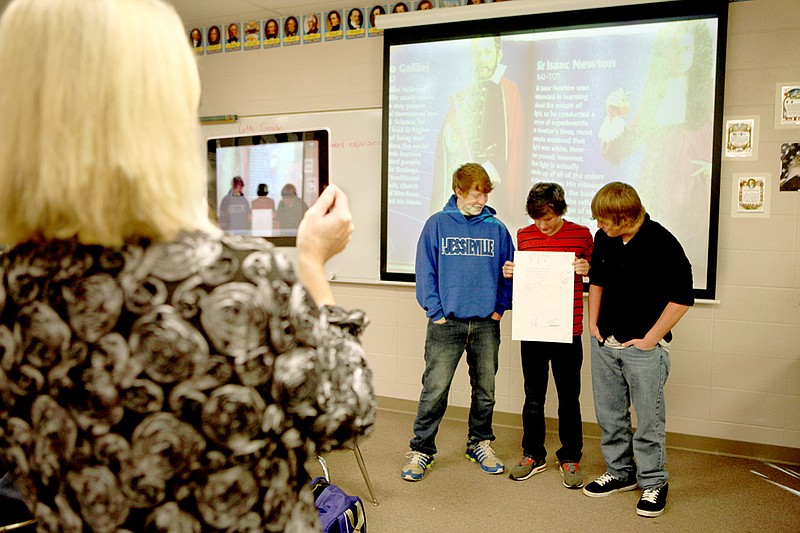JESSIEVILLE — Nancy Hendrix, a science teacher for sixth-, seventh- and eighth-graders in the Jessieville School District, takes a project tray from her supplies and sits it on a table.
It is more than 3 feet long, more than a foot wide, and looks to be about 4 inches deep. In it she places a small structure that crosses the width of the tray. For the past nine weeks, she has been helping her students build dams that would control the flow of water in the trays.
“We had about four teams per classes and we built 48 dams,” Hendrix said. “Some of them worked better than others.
The dam-building was the first of several projects students will undertake at school this year. Arkansas educators are looking at different ways to teach its young people, and the teachers at Jessieville are exploring a new approach to sharing information with the students.
“Teachers will have to change the way they teach,” said Andy Curry, superintendent of the Jessieville School District. “They will have to become instruction facilitators of learning what can infuse standard information into the projects the kids undertake.”
Since the beginning of the school year, students of all grades have been learning through the project-based programs designed to go along with Common Core standards that will take the place of the federal No Child Left Behind testing standards.
Curry said new technologies have created new demands for educators.
“The influx of technology provides access to knowledge outside the traditional ways of learning,” he said. “If you want to learn to play the guitar or want to know more about the American Revolution, all that information is online. So, we have to make teaching different from the usual knowledge-based education.”
Curry said that with the projects, the students are moving from the Three R’s to the new Three C’s.
“Those are communication, collaboration and critical thinking or problem solving,” he said. “By the time a student gets through school, they will have worked on 60 projects, researching, designing, building and making presentations about what they have done.”
That experience develops these skills in a “very impressive way,” the superintendent said.
“The student is engaged in the learning process,” Curry said. “They can take charge of their own learning.”
According to the project-based learning plan, that engagement will create more interest in education for the students and provide training while working on real-world projects.
Hendrix said the student dams could have been made from a number of materials available in the classroom, from plastic containers to modeling clay and wooden craft sticks.
“They could not use concrete or duct tape,” Hendrix said, “and all the work had to be done at school.”
While doing the project, the students had to find out how dams were made and their purpose, the teacher said.
“That research gave them the different parts of a dam and gave them a vocabulary to use in their designs,” Hendrix said.
The student teams handed in designs and could make either a simple dam that just blocked the water, or for a higher grade, they could build in way that allowed water to get though in a controlled and useful manner.
Hendrix said the building project and presentations of the work gave students real-world training in grammar, writing, construction, the sciences of water and energy, as well as research in flood control, water supply, recreation and other uses for a dam and the lake it could create.
“The project was surprisingly successful,” the teacher said. “I expected the best work from the eighth-graders, but that was not always the case. It was based on being creative.
Hendrix said the time used on the projects did cause some of the information covered in more traditional classrooms to be omitted, but that the engagement of the students on the projects overcame any shortcomings.
This was the first project for the science classes this year, and Hendrix said she was learning along with the children.
“The teachers like the new program,” said Toby Packard, principal of Jessieville High School. “Some of our most experienced teachers were the first to embrace the program, but they all want more training.”
In an eighth-grade world history class, Gaye Johnson was teaching her students about the lives of three of the great scientists, Galileo Galilei, Nicolaus Copernicus and Issac Newton. The students researched the three men whose discoveries changed the world and altered the way people thought about the universe. They also placed the great thinkers in their historical and social contexts.
“They had to write a poem about the men, and others made a poster telling about each scientist,” Johnson said.
Their presentations are recorded on computers and showed to parents during teacher-parent conferences, she said.
The students said the projects were more fun and more interesting than they would if been if they had just read about them in a textbook.
“We got to use some of our own ideas and we spent longer on the project,” said Drew Galloway, an eighth-grader.
The project-based learning program is being used in other school systems in the region, including Arkadelphia and Fountain Lake. Jessieville teachers are considering a new program for high school students known as High Tech that might be used next year. The project would use more technology to build skill sets of students from their life after high school.
Staff writer Wayne Bryan can be reached at (501) 244-4460 or wbryan@arkansasonline.com.
